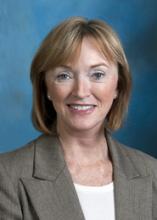WASHINGTON – The nation’s health bill is slated to continue to grow slowly through the end of this year, but that trend is not attributable to the Affordable Care Act. Instead, health reform is likely to increase health spending in 2014, as potentially 11 million Americans gain health insurance through the law next year, according to government economists.
By 2022, the ACA is expected to cut the number of uninsured by 30 million, but also add about 0.1% to the nation’s health tab each year, adding up to an additional $621 billion over the next decade, according to an annual estimate of trends in health spending by analysts from the Centers for Medicare and Medicaid Services published in Health Affairs Sept. 18. (doi:10.1377/hlthaff.2013.0721).
The economists found that in 2012 spending overall grew only 3.9%, to $2.8 trillion. Spending is likely to stay under 4% in 2013, in line with the historically low rate of growth seen over the past few years, said the economists.
The decrease in health spending cannot be attributed to the Affordable Care Act, which became law in 2010, they said.
"In our projections, we have incorporated some modest savings regarding delivery system reforms, however, at this time it’s a little too early to tell how substantial those savings will be in the longer term," Gigi Cuckler, an economist in the CMS Office of the Actuary, told reporters.
The most recent downturn in spending is being driven by bigger trends. What has been seen over the past 50 years is that when the economy shrinks, so does health spending, said Ms. Cuckler. When the economy recovers, the nation spends more on health care.
"Until we see evidence that relationship has been broken, it’s very difficult for us to conclude that something structural has occurred," said Stephen Heffler, also of the Office of the Actuary at the CMS.
CMS Administrator Marilyn Tavenner, however, said that the trends showed that "we are on the right track to controlling health care costs, thanks in part to the Affordable Care Act." She added that the CMS had "identified several areas where our reforms to control costs are making progress, and we must build on those efforts in the years ahead."
Health costs also slowed in 2012, and likely will this year as well, because of a continued ratcheting down of costs in Medicare and Medicaid. Employers also shifted more workers into high-deductible, high-cost health plans, so they, in turn, cut back on their use of physician services and prescription drugs.
Medicare spending grew by 4.6% in 2012, down from 6.2% growth in 2011. Factors included lower spending on skilled nursing facilities; lower spending on prescriptions drugs such as Plavix (clopidogrel) , which went off-patent; and lower payments to some providers mandated by the ACA. This year, Medicare spending will grow even more slowly, in part from a continued slowdown in spending on hospitals and physicians. The automatic 2% spending cut mandated by sequestration will also play a role.
Medicaid spending grew just over 2% in 2012, in part because the federal government reduced its matching rate and because states employed major cost-containment efforts. But Medicaid is expected to grow by almost 5% in 2013, partly because primary care physicians were being paid at the higher Medicare rate.
In 2014, when millions of Americans are expected to gain insurance coverage through the ACA, health spending is expected to grow by 6% – that’s almost 2% faster than would have been expected if the law were not in effect. The main spending drivers in 2014 will be growth in Medicaid and growth in private health insurance. Even though only about half of the states have said they will expand Medicaid eligibility, the expansion will lead to a 12% increase in spending on the program, primarily by the federal government.
The CMS economists said they expected the newly insured to be mostly young and healthy, and therefore likely to spend less on acute care and hospitalizations but more on prescription drugs and physician services. They projected a 7% increase in overall spending on physician services in 2014 – compared to just under 5% in 2012 and around 4% in 2013. But that 7% figure would drop to a little under 5% if Congress allows the scheduled 25% cut in physician payment rates – mandated by Medicare’s Sustainable Growth Rate formula – to go into effect in January.
During 2015-2018, physician spending is expected to grow by at least 5% a year, in part because of increased demand with more people gaining insurance, said the CMS economists.


